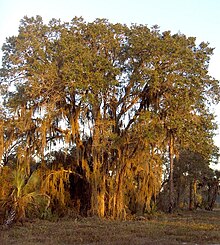Live oak
- This article is about the live oak tree. For places named Live Oak, see Live Oak.

Live oak (Quercus virginiana), also known as the southern live oak, is a normally evergreen oak tree native to the southeastern United States. Though many other species are loosely called live oak, the southern live oak is particularly iconic of the Old South.[1]
When the term live oak is used in a specific rather than general sense, it most commonly refers to the southern live oak (the first species so named), but can often refer to other species regionally.
The southern live oak is the official state tree of Georgia.
In Texas, a small grove of trees, such as live oaks (Texas live oak or southern live oak) or elm, is known as a mott.[2]
Wood and lumber
Live oak was widely used in early American butt shipbuilding. Because of the trees' short height and low-hanging branches, lumber from live oak was specifically used to make curved structural members of the hull, such as knee braces (single-piece, inverted L-shaped braces that spring inward from the side and support a ship's deck). In such cuts of lumber, the line of the grain would fall perpendicularly to lines of stress, creating structures of exceptional strength. Live oaks were not generally used for planking because the curved and often convoluted shape of the tree did not lend itself to be milled to planking of any length. Red oak or white oak was generally used for planking on vessels, as those trees tended to grow straight and tall and thus would yield straight trunk sections of length suitable for milling into plank lengths.
Live oak was largely logged out in Europe by the latter half of the 19th century, and was similarly sought after and exported from the United States until iron- and steel-hulled commercial vessel construction became the standard early in the 20th century. Live oak lumber is rarely used for furniture due to warping and twisting while drying.
It continues to be used occasionally when available in shipbuilding, as well as for tool handles for its strength, energy absorption, and density, but modern composites are often substituted with good effect. Dry southern live oak lumber has a specific gravity of 0.88, among the highest of North American hardwoods.
List of evergreen species in genus Quercus
- Section Quercus. The white oaks - Europe, Asia, North Africa, North America, styles short; acorns mature in 6 months, sweet or slightly bitter, inside of acorn shell is hairless
- Quercus arizonica - Arizona white oak - southwestern North America
- Quercus fusiformis - (also Quercus virginiana var. fusiformis) Texas live oak - south central North America
- Quercus geminata - sand live oak - southeastern North America
- Quercus hinckleyi - Hinckley oak - Texas
- Quercus ilex - Holm oak - southern Europe
- Quercus minima - dwarf live oak - southeastern North America
- Quercus oblongifolia - Mexican blue oak - southwestern North America
- Quercus polymorpha - Mexican white oak or Monterrey oak - Mexico
- Quercus pungens - sandpaper oak - south central North America
- Quercus turbinella - shrub live oak - southwestern North America
- Quercus virginiana - southern live oak - southeastern North America
- Section Cerris. Europe, Asia, north Africa. Styles long; acorns mature in 18 months, very bitter, inside of acorn shell is hairless or slightly hairy
- Quercus calliprinos - Palestine oak - western Asia
- Quercus coccifera - Kermes oak - southern Europe
- Quercus semecarpifolia - Himalayan oak - eastern Asia
- Quercus suber - Cork oak - southwestern Europe
- Section Protobalanus - Southwest USA, California coastal ranges and northwest Mexico, styles short, acorns mature in 18 months, very bitter, inside of acorn shell is woolly
- Quercus chrysolepis - canyon live oak - southwestern North America, especially coastal ranges of California
- Quercus palmeri - Palmer oak - southwestern North America
- Quercus tomentella - Channel Island oak - Channel Islands of California
- Quercus vacciniifolia - huckleberry oak - California and southwestern North America
- Section Lobatae. The red oaks - North, Central and South America, styles long, acorns mature in 18 months, very bitter, inside of acorn shell is woolly
- Quercus agrifolia - coast live oak - California and southwestern North America
- Quercus canbyi - Canby oak - Mexico
- Quercus emoryi - Emory oak - southwestern North America
- Quercus hemisphaerica - laurel oak - southeastern North America
- Quercus humboldtii - South American oak - northern South America
- Quercus laurifolia - swamp laurel oak - southeastern U.S.
- Quercus hypoleucoides - silverleaf oak - southwestern North America
- Quercus rhysophylla - loquat-leaf oak - Mexico
- Quercus wislizenii - interior live oak - California and southwestern North America
- See the list of Quercus species for a fuller listing of oaks, including deciduous species.
References
- ^ Bender, Steve, ed. (2004). "Quercus virginiana". The Southern Living Garden Book (2nd ed.). Birmingham, Alabama: Oxmoor House. ISBN 0-376-03910-8.
{{cite encyclopedia}}: Unknown parameter|month=ignored (help) - ^ Wheat, Pam; Whorton, Brenda (November 1990). Clues from the Past: A Resource Book on Archeology. Hendrick-Long Pub. Co. p. 18. ISBN 978-0-937460-65-8. Retrieved 20 October 2010.
